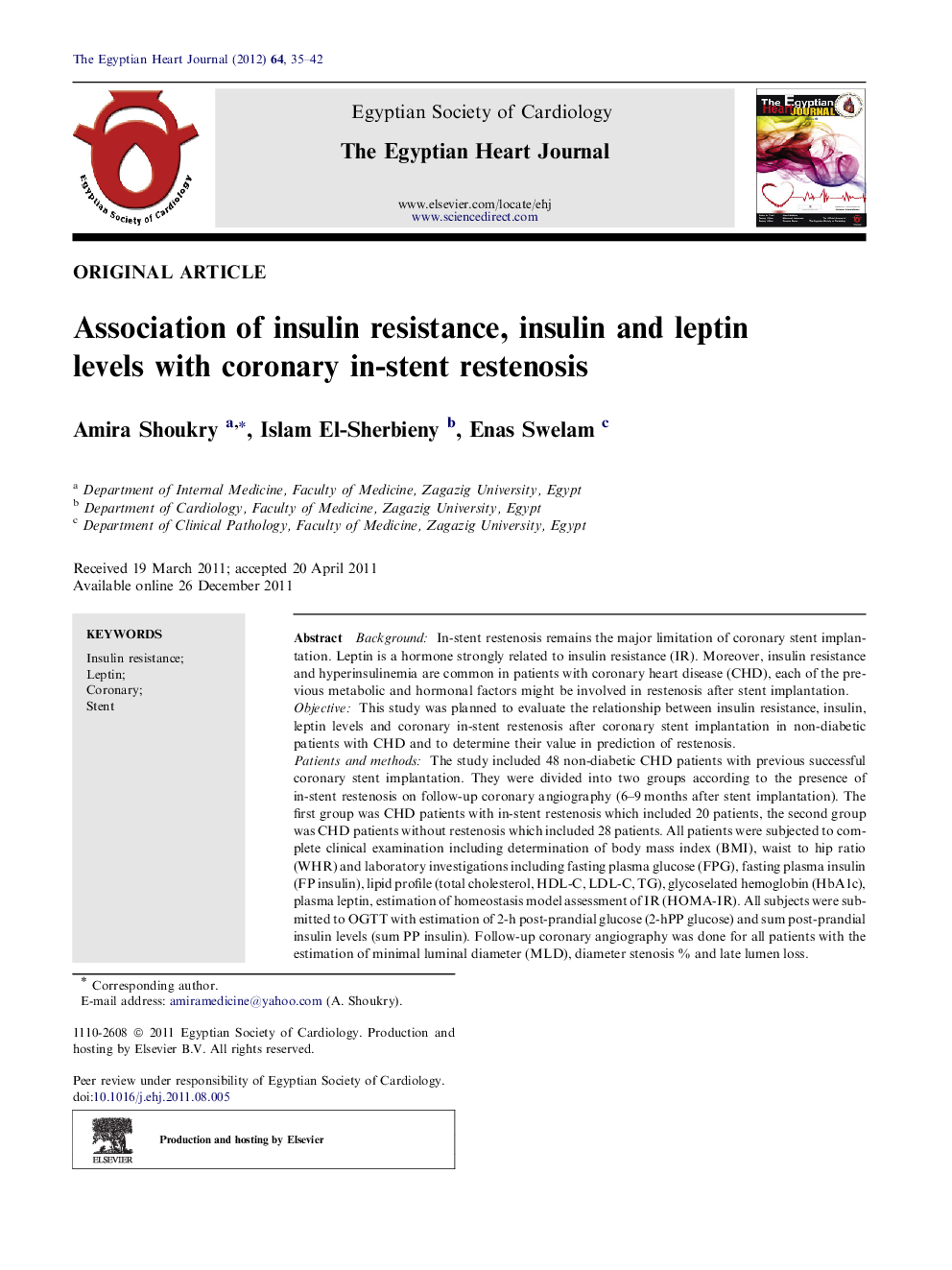| کد مقاله | کد نشریه | سال انتشار | مقاله انگلیسی | نسخه تمام متن |
|---|---|---|---|---|
| 2910467 | 1175009 | 2012 | 8 صفحه PDF | دانلود رایگان |

BackgroundIn-stent restenosis remains the major limitation of coronary stent implantation. Leptin is a hormone strongly related to insulin resistance (IR). Moreover, insulin resistance and hyperinsulinemia are common in patients with coronary heart disease (CHD), each of the previous metabolic and hormonal factors might be involved in restenosis after stent implantation.ObjectiveThis study was planned to evaluate the relationship between insulin resistance, insulin, leptin levels and coronary in-stent restenosis after coronary stent implantation in non-diabetic patients with CHD and to determine their value in prediction of restenosis.Patients and methodsThe study included 48 non-diabetic CHD patients with previous successful coronary stent implantation. They were divided into two groups according to the presence of in-stent restenosis on follow-up coronary angiography (6–9 months after stent implantation). The first group was CHD patients with in-stent restenosis which included 20 patients, the second group was CHD patients without restenosis which included 28 patients. All patients were subjected to complete clinical examination including determination of body mass index (BMI), waist to hip ratio (WHR) and laboratory investigations including fasting plasma glucose (FPG), fasting plasma insulin (FP insulin), lipid profile (total cholesterol, HDL-C, LDL-C, TG), glycoselated hemoglobin (HbA1c), plasma leptin, estimation of homeostasis model assessment of IR (HOMA-IR). All subjects were submitted to OGTT with estimation of 2-h post-prandial glucose (2-hPP glucose) and sum post-prandial insulin levels (sum PP insulin). Follow-up coronary angiography was done for all patients with the estimation of minimal luminal diameter (MLD), diameter stenosis % and late lumen loss.ResultsThere was highly significant increase in each of FP insulin, sum PP insulin, HOMA-IR, leptin, diameter stenosis % and late lumen loss (P < 0.001) and a highly significant decrease of MLD (P < 0.001) in CHD patients with in-stent restenosis when compared to CHD patients without in-stent restenosis. MLD is negatively correlated to each of FP insulin (r = −0.49, P < 0.001), sum PP insulin (r = −0.60, P < 0.001) HOMA-IR (r = −0.63, P < 0.001) and leptin (r = −0.55, P < 0.001) while late lumen loss was positively correlated to each of FP insulin (r = 0.98, P < 0.001), sum PP insulin (r = 0.70, P < 0.001), HOMA-IR (r = 0.67, P < 0.001) and leptin (r = 0.72, P < 0.001). Multiple regression analysis revealed that each of FP insulin, sum PP insulin, HOMA-IR and leptin can be considered an independent predictor of in-stent restenosis (P < 0.001).ConclusionOur study revealed that insulin resistance, fasting and post-prandial hyperinsulinemia and hyperliptinemia are considered predictors of coronary in-stent restenosis. Evaluation of HOMA-IR, insulin levels after standard OGTT and leptin levels are important tools in an attempt to recognize subjects at risk of early restenosis among non-diabetic, CHD patients undergoing percutaneous coronary revascularization and stent implantation.
Journal: The Egyptian Heart Journal - Volume 64, Issue 1, March 2012, Pages 35–42